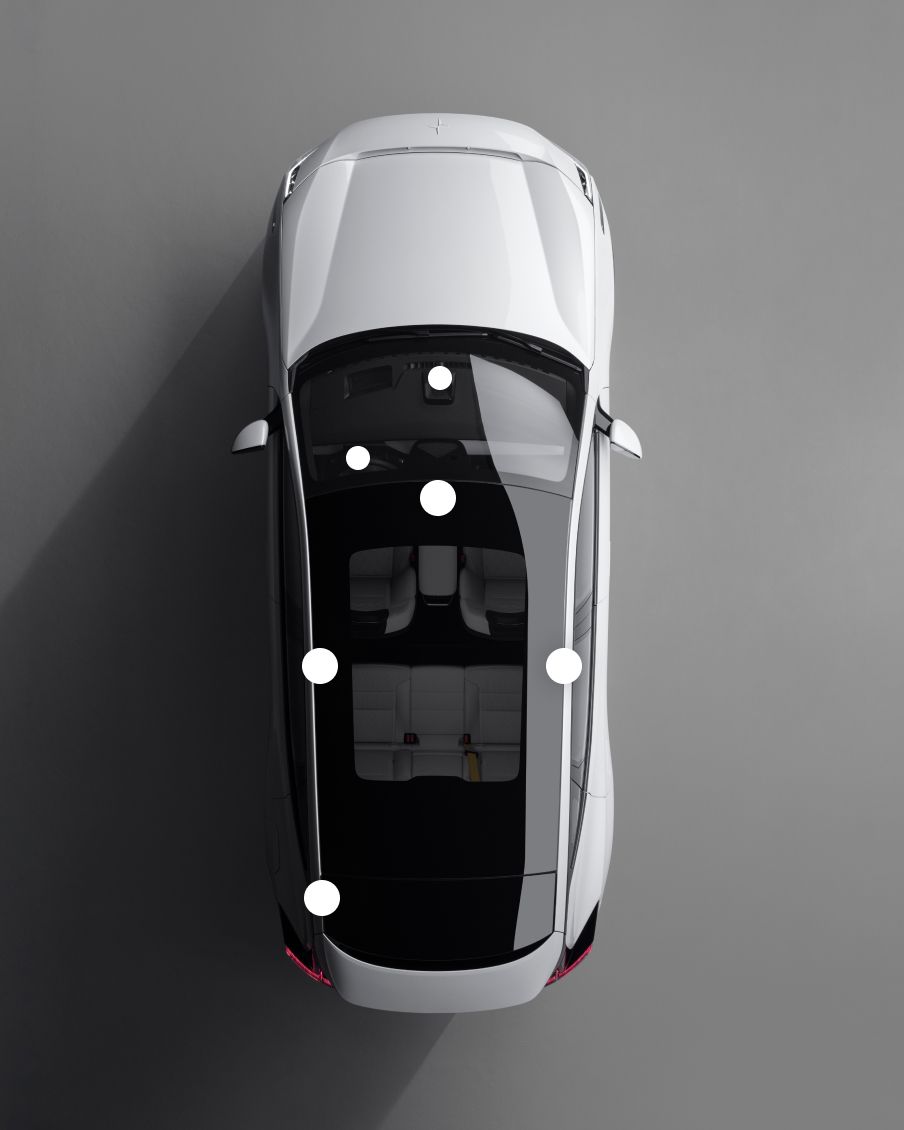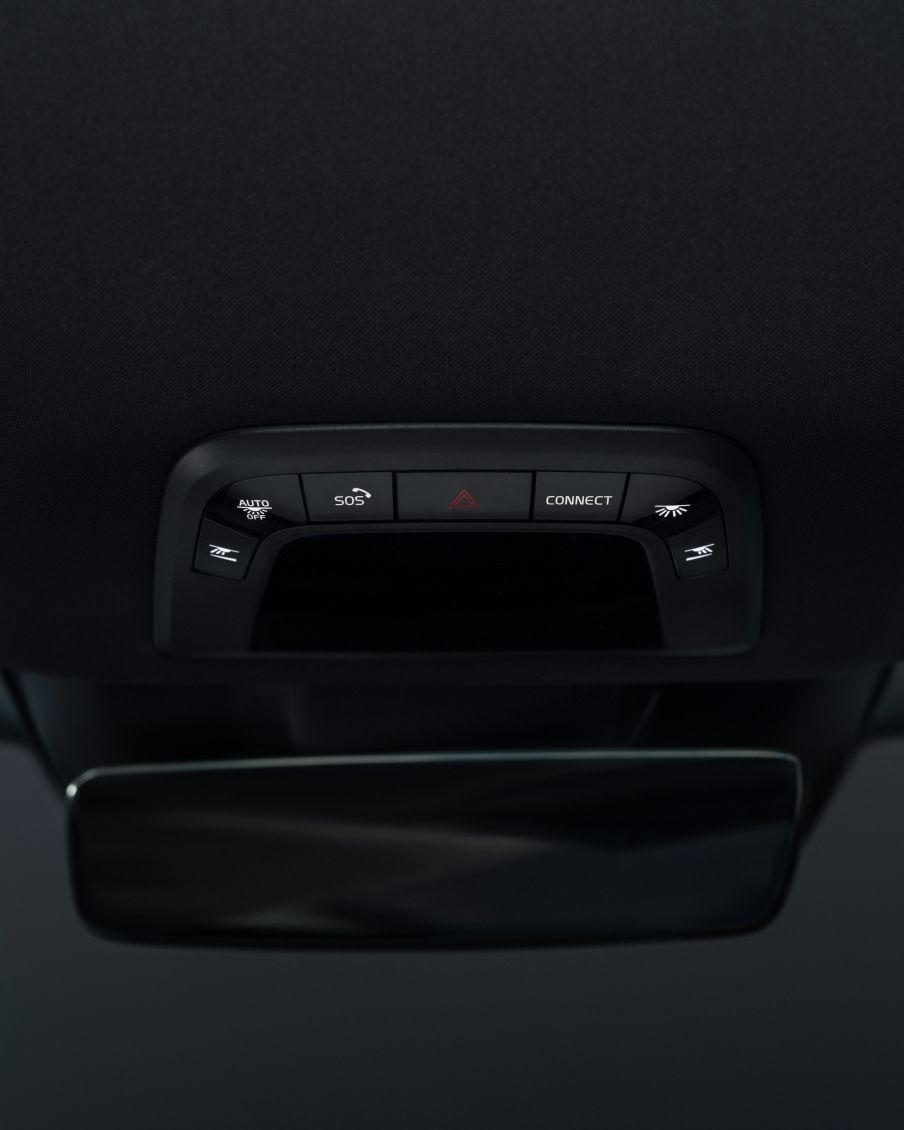- Exterior
- Interior
- Performance
- Range and charging
- Infotainment
- Safety
- Protective and preventive technology
- Hardware and sensors
- Driver Monitoring System
- Occupant Detection System
- Blind Spot Information System
- Forward collision avoidance
- Lane departure prevention
- Parking sensors and assistance
- Adaptive Cruise Control with steering assistance
- Intelligent lighting
- Acoustic Vehicle Alert System
- Post-impact protection
- Utility
- Sustainability
- Owning a Polestar 3
- Upgrades
Safety
Protective and preventive technology
Because Polestar and Volvo Cars share engineering expertise, Polestar 3 is built on almost 100 years of ground-breaking safety development. The car is designed with the latest structural innovations to protect its occupants, while advanced sensor technology helps to prevent collisions, and safeguard vulnerable road users like pedestrians and cyclists.

Hardware and sensors
Twelve ultrasonic sensors, five radars, five cameras, two driver-monitoring sensors, four interior radars. Substantial on-board computing power converts sensor data into preventative warnings, and intervenes when needed.
SmartZone: From breathing to seeing
The grille of traditional cars allowed the engine to breathe. The SmartZone at the front of Polestar 3 hosts a radar and a camera that enable the car to see. With sensors looking out for potentially dangerous situations, the car is always aware of its surroundings with the aim of keeping occupants and other road users safe at all times.

Interior radars and cameras
Advanced cameras and radar sensors inside Polestar 3 monitor drivers and occupants. There are two infrared eye-tracking cameras in the dashboard, as well as four 60 GHz motion-detecting radars. The radar system is the first of its kind to cover the entire interior of the car, including the rear luggage area.
LiDAR from Luminar
Detect objects up to 250 meters away and gain enhanced assisted driving features in darkness and generally poor conditions thanks to the powerful 1550 nm wavelength. The LiDAR unit is complemented by two additional 8-megapixel rear view cameras and one additional 8-megapixel long-range camera, as well as automatic cleaning functionality and an additional central computer by NVIDIA.
Available with the Pilot pack with LiDAR.
Driver Monitoring System
Two infrared eye-tracking cameras monitor the driver’s eyelids, gaze direction, and head movement. If the system detects that the driver is drowsy or distracted, it activates audible and visual alerts. In case of sudden sickness or unconsciousness, the system initiates an emergency stop manoeuvre. The cameras don’t store or share what they see.

Occupant Detection System
Avoid accidentally leaving a child or pet in the car. When locking Polestar 3, four interior radars check for motion inside the entire cabin, including the rear luggage compartment. If even the tiniest movement is detected, the system prevents locking and displays a reminder, as well as emitting an audible alert if the driver is walking away. Drivers can still choose to lock the car via the centre display. This also keeps the car’s climate system active, improving comfort and helping to lower the risk of hypothermia or heatstroke.

Blind Spot Information System
If a vehicle is about to pass Polestar 3, the Blind Spot Information System alerts the driver with a warning light integrated in the frameless mirrors. If the system senses that the driver intends to switch lanes, the steer assist function guides Polestar 3 back into its lane.
Forward collision avoidance
Day or night, in all conditions, Polestar 3 monitors the surrounding environment using an array of sensors and advanced technology. When it detects pedestrians, cyclists, or traffic anomalies at intersections, the car warns the driver. If the driver doesn't brake in time, the car brakes automatically to avoid or mitigate the potential impact.
Lane departure prevention
Lane Keeping Aid
If Lane Keeping Aid senses that the car is about to cross a lane marking without using the indicators, it gently steers the car back into its lane. If this fails to correct the issue, it alerts the driver by vibrating the steering wheel.
Lane departure prevention
Run-off Road Mitigation
Keep the rubber on the road. If Polestar 3 strays towards the road shoulder, Run-off Road Mitigation helps steer the car back. If the car still manages to leave the road surface, it applies the brakes and prepares the seat belts for potential impact.
Parking sensors and assistance
Polestar 3 uses its cameras and sensors to help navigate in and out of parking spots, into narrow streets and around corners. The car warns the driver of potential hazards, and can also take preventative action when needed.
360° and rear-view cameras
When manoeuvring, Polestar 3 shows a bird’s-eye view of its surroundings. Park Assist uses 360° ultrasonic sensors and fisheye cameras to measure the distance to obstacles at the front and the rear of the car, and warns the driver visually and audibly to avoid collisions.
Cross Traffic Alert with auto-brake
When reversing out of a driveway, parking space or around a corner, Cross Traffic Alert uses Polestar 3’s rear radars to scan for approaching cars, cyclists, and pedestrians. Following visible and audible warnings, the auto-brake engages to stop the vehicle if there is a risk of a collision.
Park Assist Pilot
Park Assist Pilot allows Polestar 3 to detect suitable parking spaces at speeds up to 30 km/h and guide itself into the one selected on the centre display. The system can handle parallel, perpendicular, or diagonal parking, as long as the driver is present.
Available as an upgrade.
Adaptive Cruise Control with steering assistance
Go with the flow. Adaptive Cruise Control monitors the speed and distance of the vehicles in front and adjusts Polestar 3’s speed accordingly. This feature works at speeds up to 150km/h.
Pilot Assist
Pilot Assist delivers a more relaxed driving experience on motorways and major roads. Once the driver has selected the desired speed and a time interval to the vehicle ahead, Pilot Assist monitors the distance to the vehicle ahead, the lane markings, and makes automatic speed and steering adjustments to maintain the preferred position.
Available as an upgrade.
Lane change assist
When Pilot Assist is active, Polestar 3 can also change lanes automatically. Moving the indicator stalk fully up or down initiates the manoeuvre, and the car will only proceed if the system’s sensors indicate it’s safe.
Available as an upgrade.
Intelligent lighting
Polestar 3’s new generation LED headlights can automatically switch between low and high beam. The beam level is constantly adjusted for optimal illumination, regardless of the load being carried. The optional 1.3 megapixel HD LED headlights make driving safer and more relaxing, by providing unlimited possibilities to adapt the light spread, according to light-, weather- and traffic conditions.
1.3 megapixel HD LED
The megapixel technology used in the HD LED headlights automatically adapts the spread of the beam to the car’s surroundings. Guided by cameras, the 1.3 million pixel modules in each lamp unit reduce glare by shading out oncoming and preceding vehicles as well as reflective road signs, focusing the beam on where it’s needed.
Available as an upgrade.
Active High Beam
The advanced Active High Beam system detects both oncoming traffic and cars in front of Polestar 3, automatically switching to low beam to avoid blinding other drivers.
Rear light warning sequence
Polestar 3 actively works towards improving the safety of all drivers. If the brake pedal is depressed very quickly, the onboard systems sense a possible emergency and the rear lights automatically show a warning sequence.
Acoustic Vehicle Alert System
An unobtrusive way to let pedestrians and cyclists know that Polestar 3 is approaching or reversing. Using three external speakers, the Acoustic Vehicle Alert System (AVAS) generates unique, distinctive sounds that help the car make itself heard, increasing safety for vulnerable road users.
01/02
Post-impact protection
A well-designed body structure is crucial when it comes to safety. Polestar 3’s passenger compartment is equipped with 9 airbags, and constructed using ultra-high strength steel. The car’s front and rear crumple zones use a mix of materials to absorb and dissipate energy, protecting occupants in impact situations.

Post-impact braking
Post-impact braking reduces the risk of serious injury or damage to the vehicle, as well as the severity of a potential secondary collision. When the airbags and the seatbelt pretensioners are deployed during an impact, on-board sensors signal the brakes to bring the car to a controlled standstill, reducing the after-effects of the impact.

Direct assistance
The overhead console includes two buttons that can make direct calls in case of a breakdown or an accident. The Connect button is used to reach Polestar Assistance for events like a flat battery, or a puncture. The SOS button is intended for emergency situations such as accidents. In case of a severe accident, Polestar 3 automatically calls for help.

Common electric driving questions answered
Learn moreExplore fleet and business benefits
Learn moreMaintenance, service and warranty
Learn more- Visuals are for illustrative purposes only.